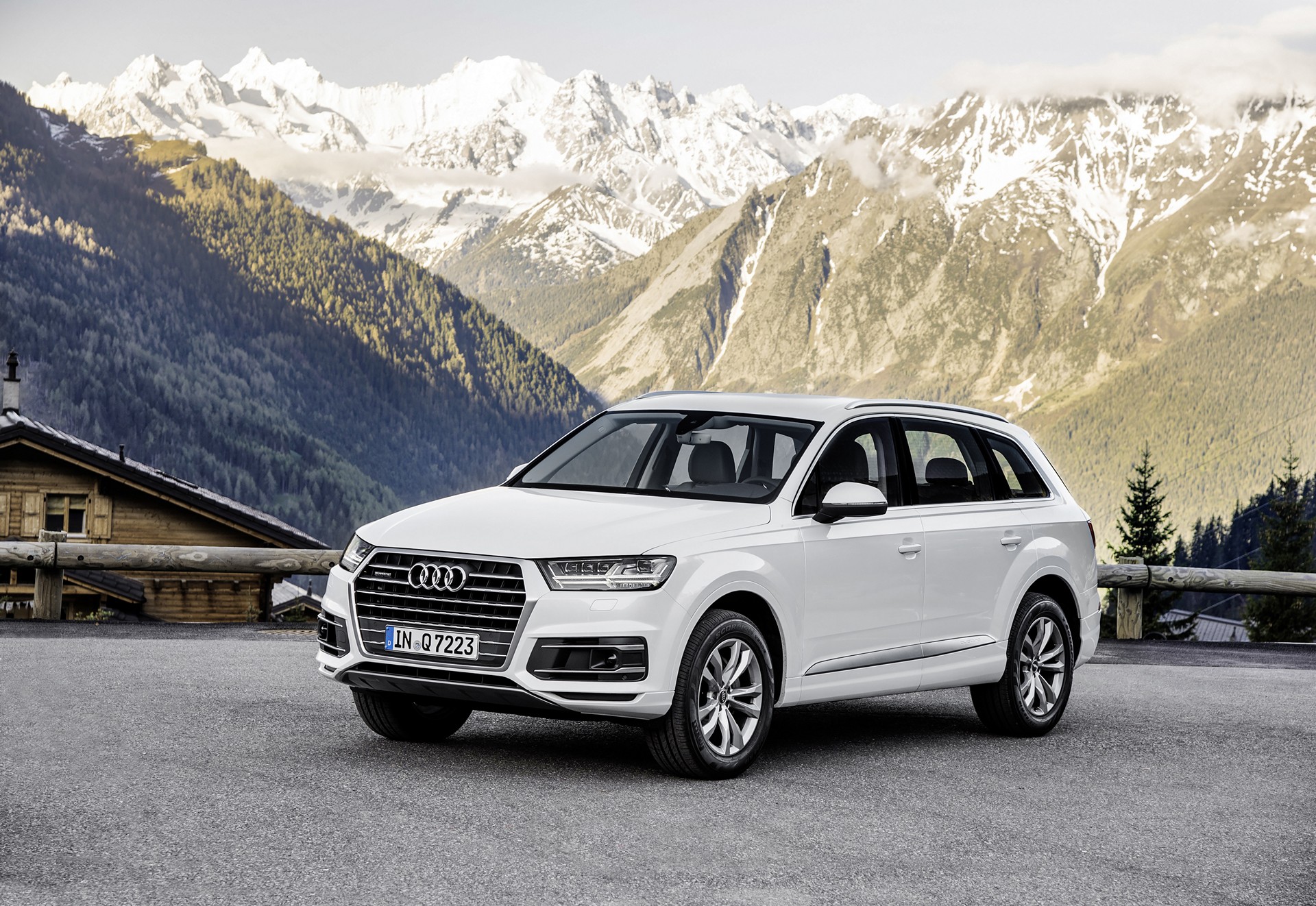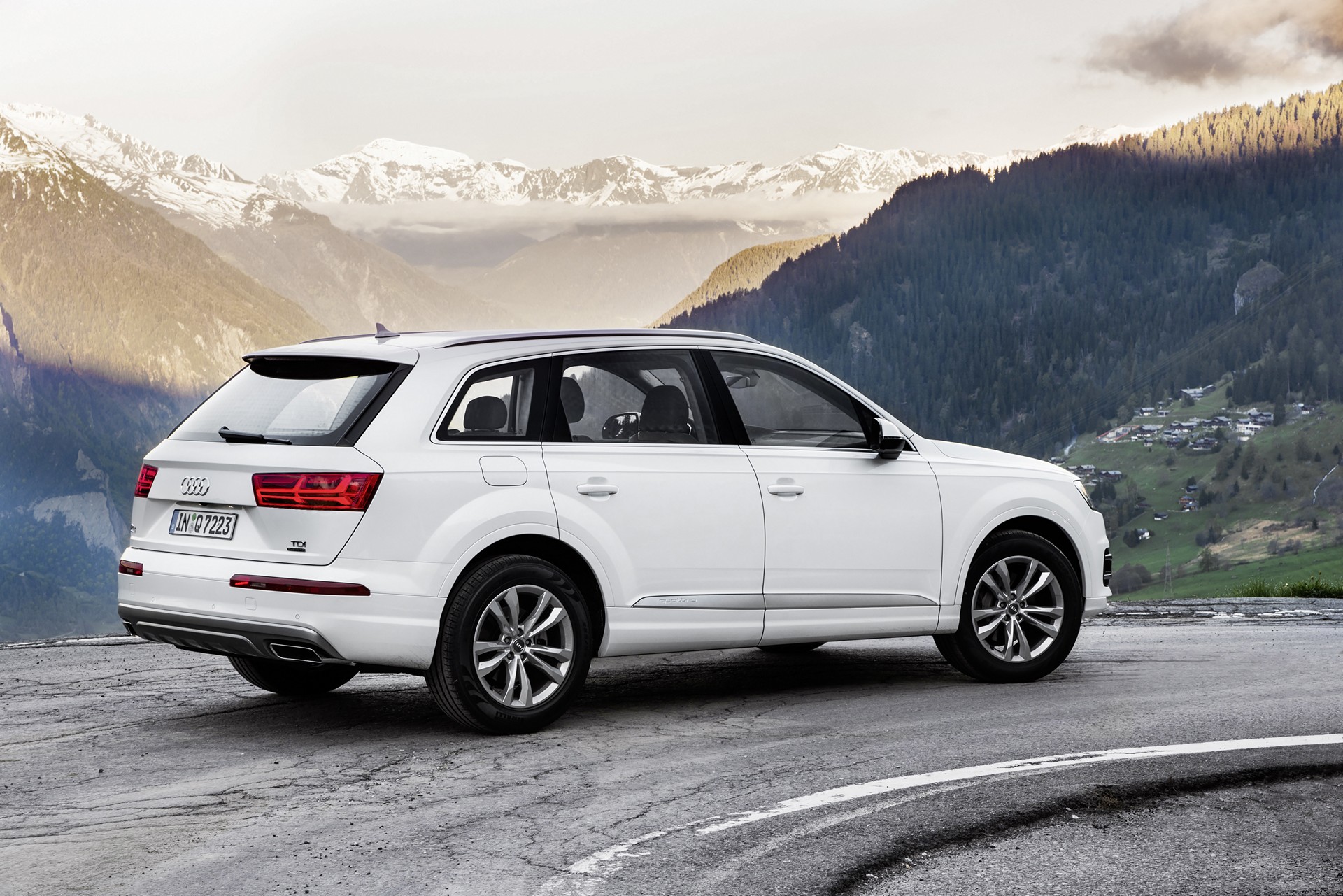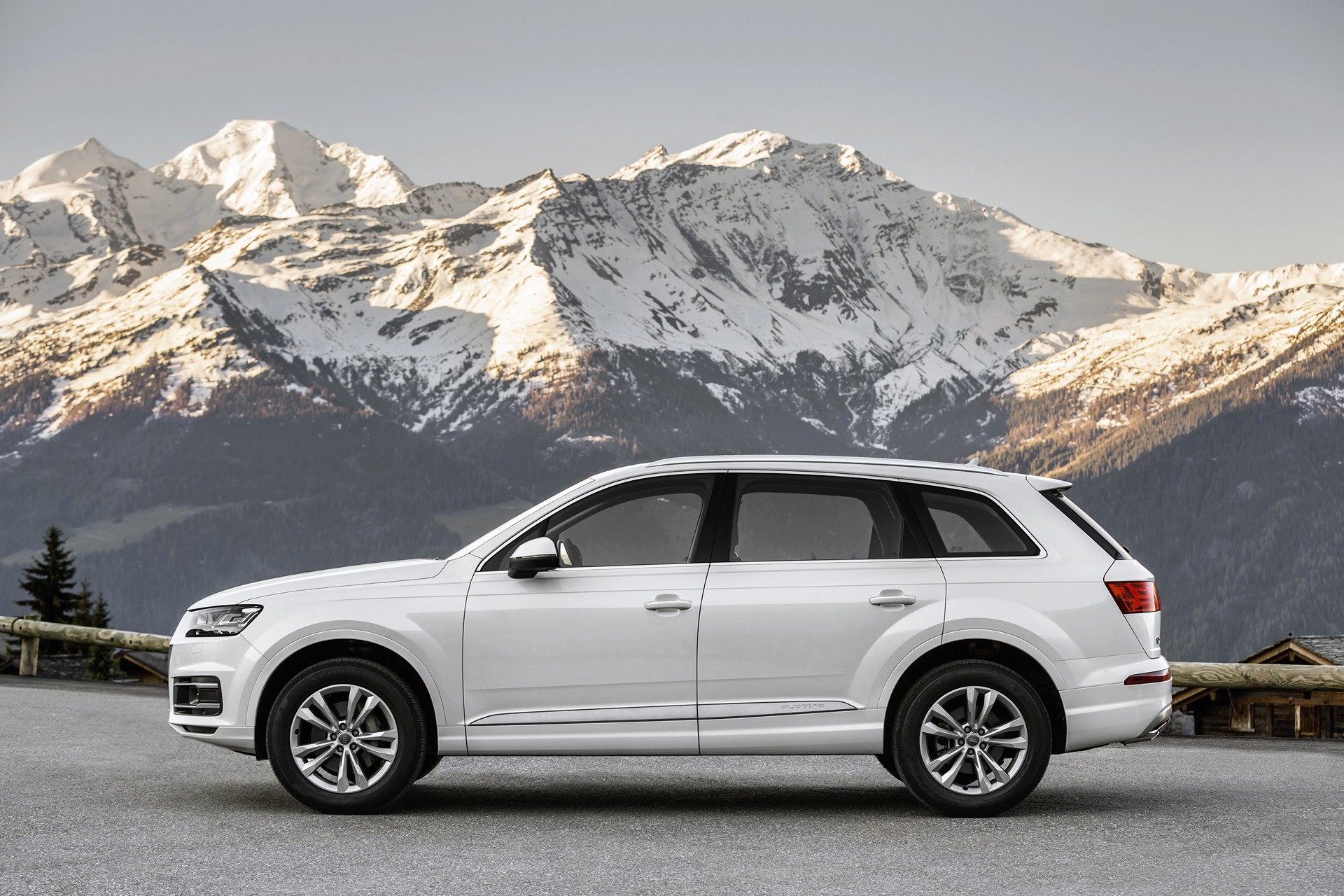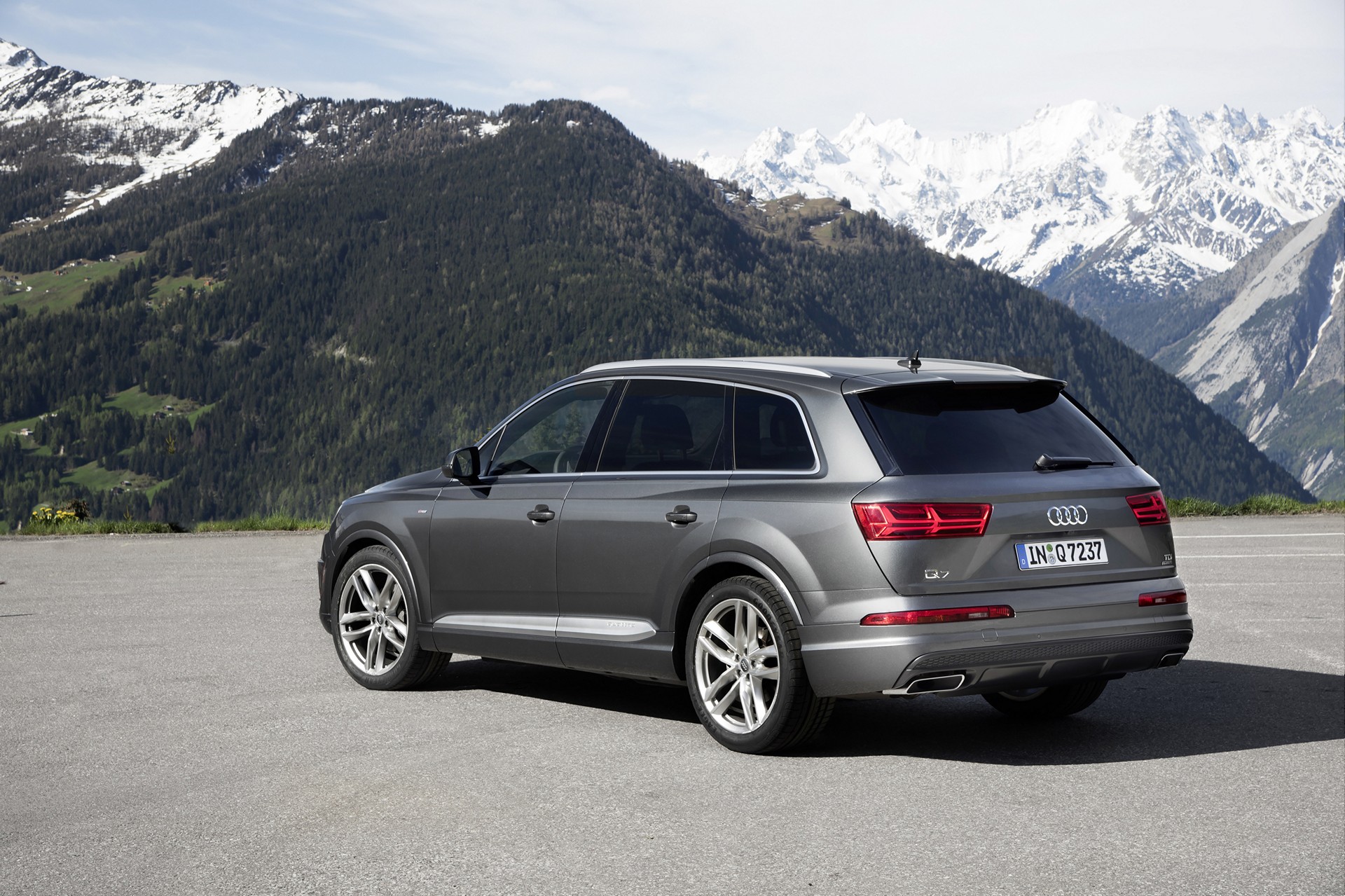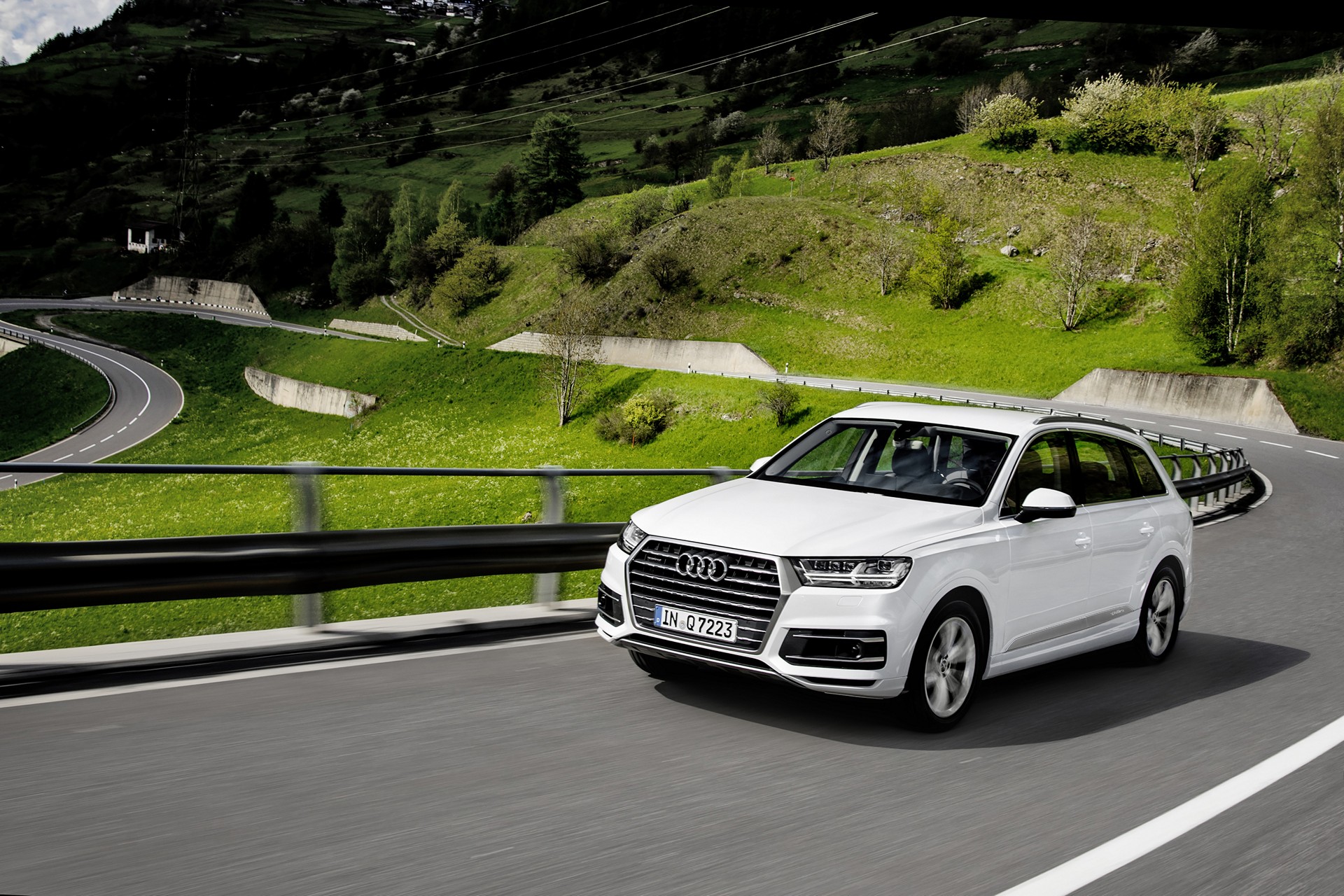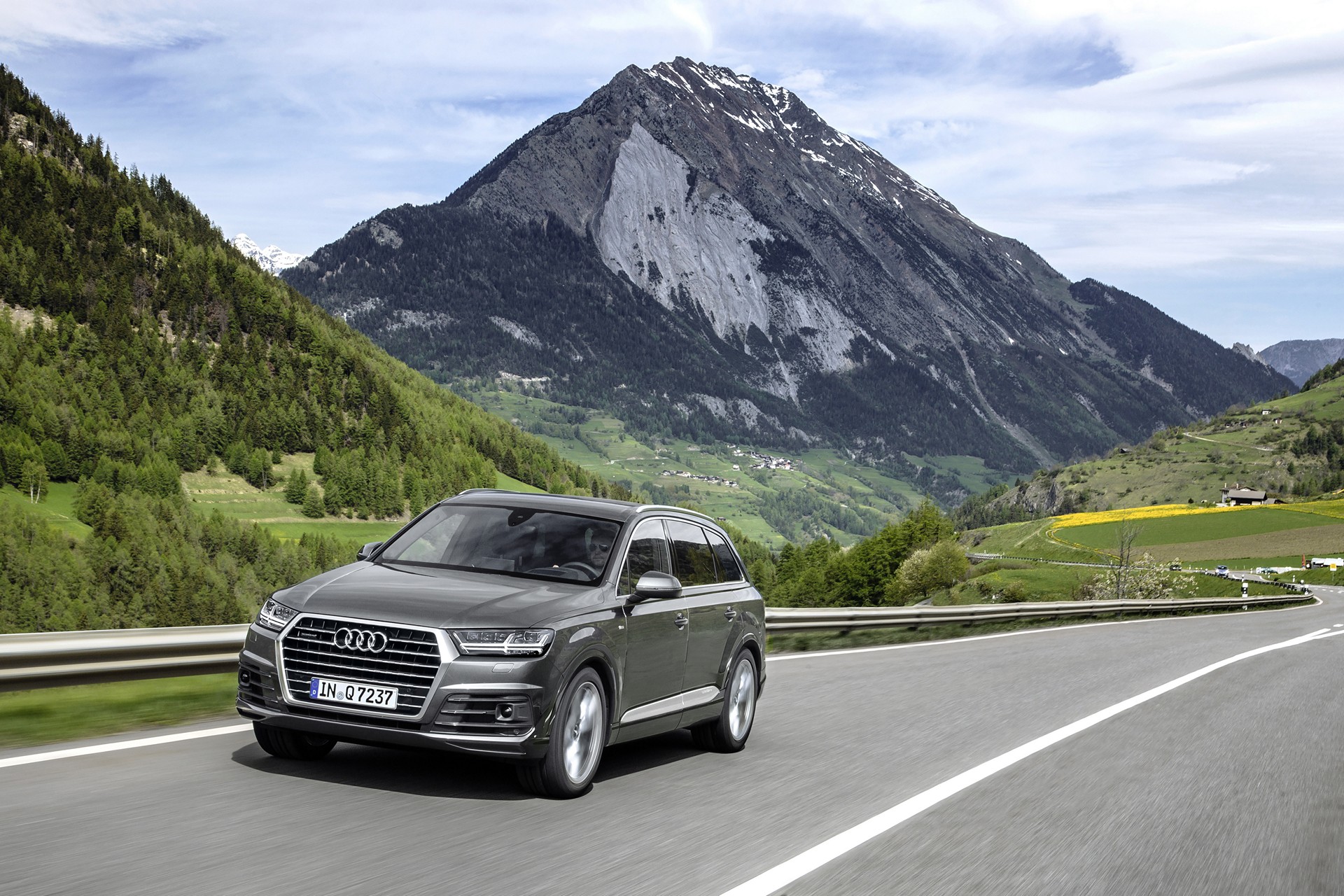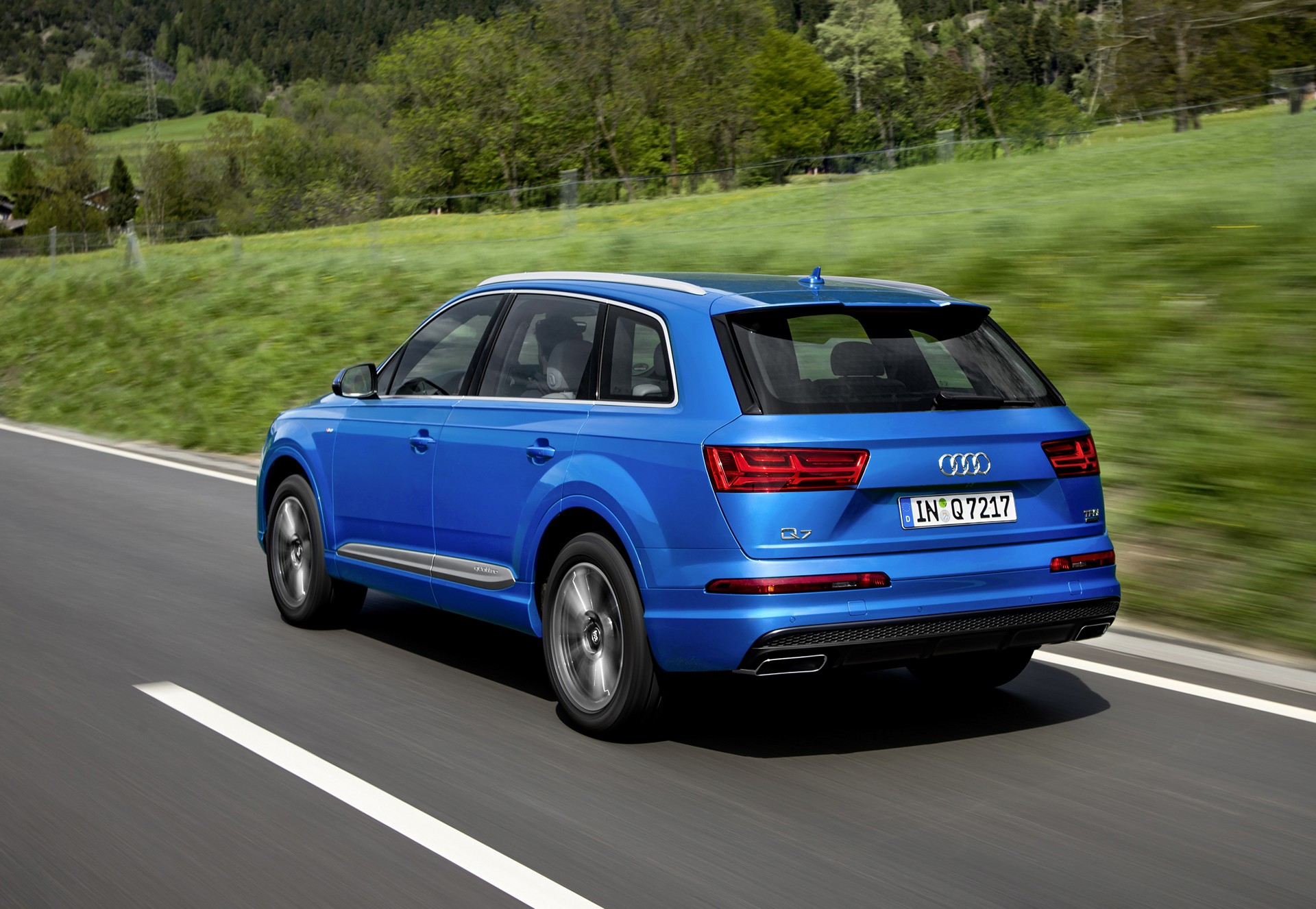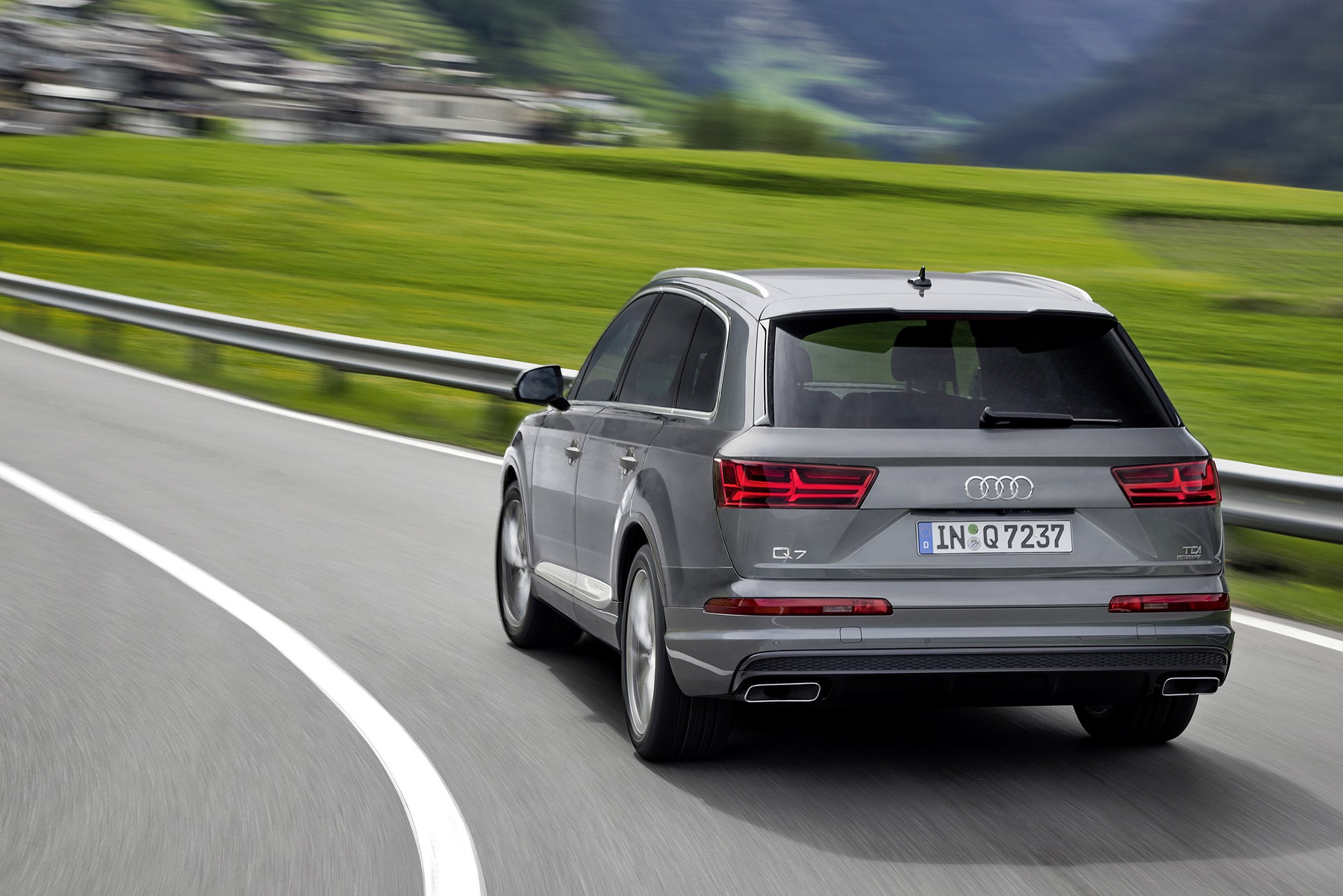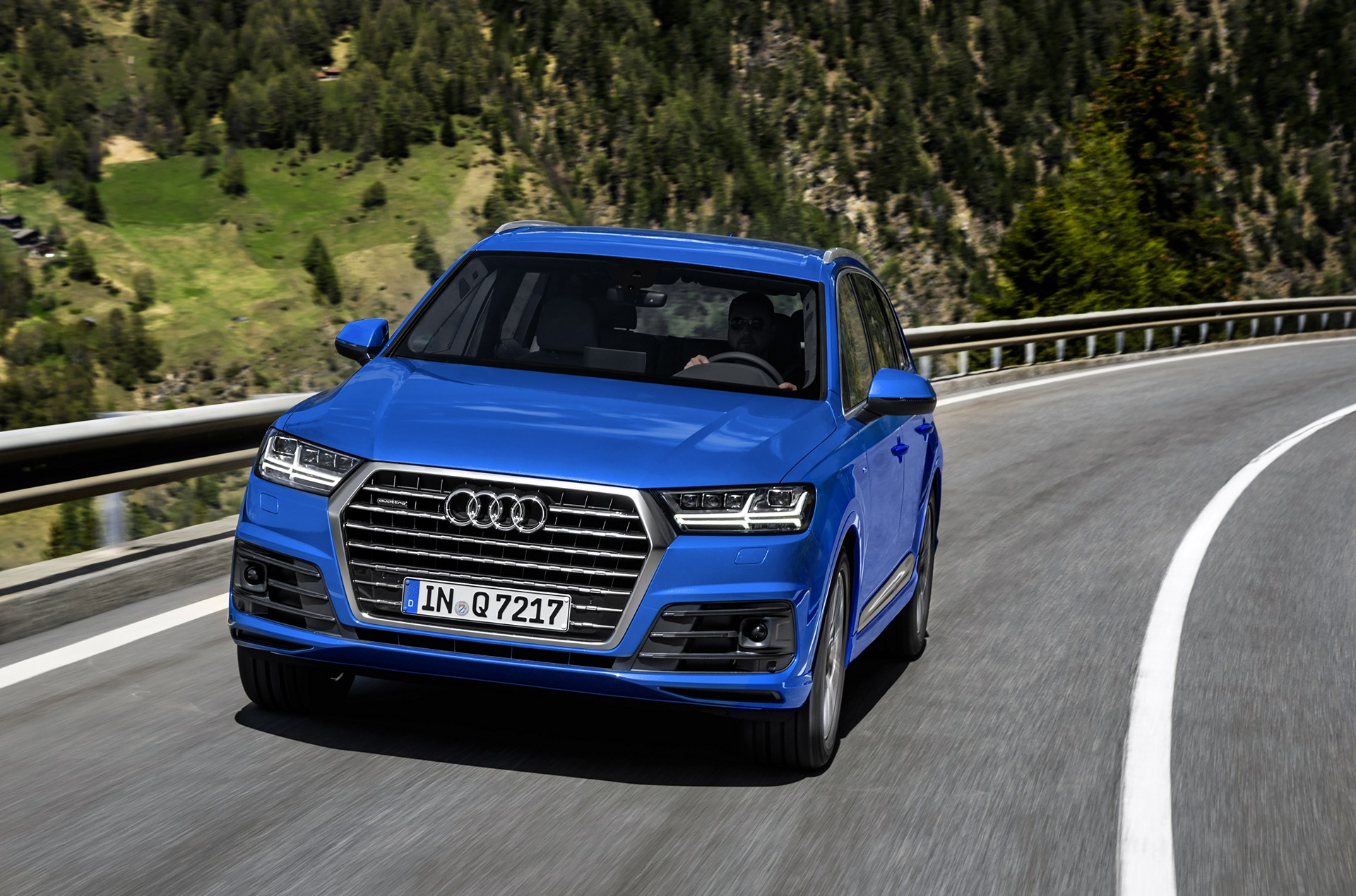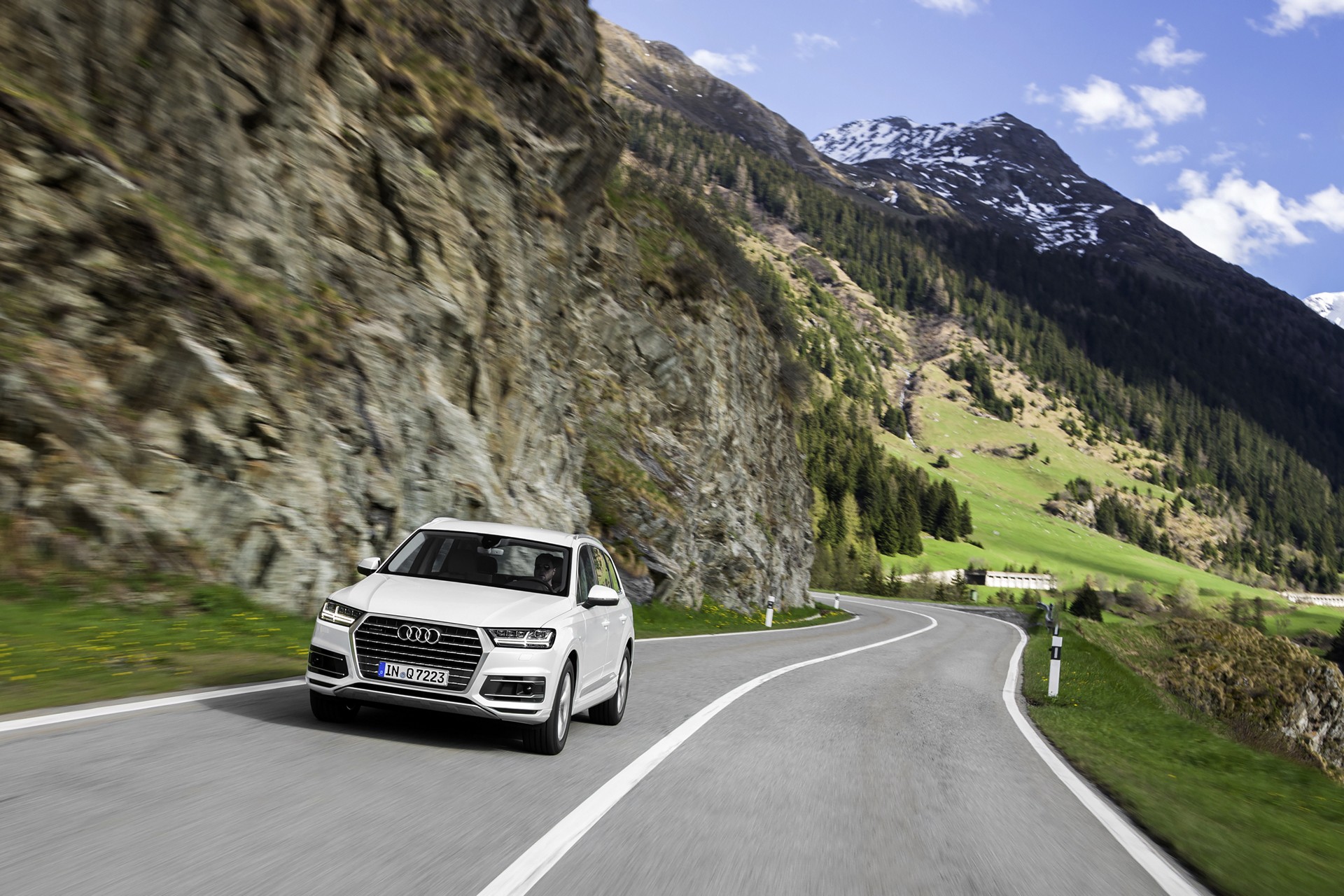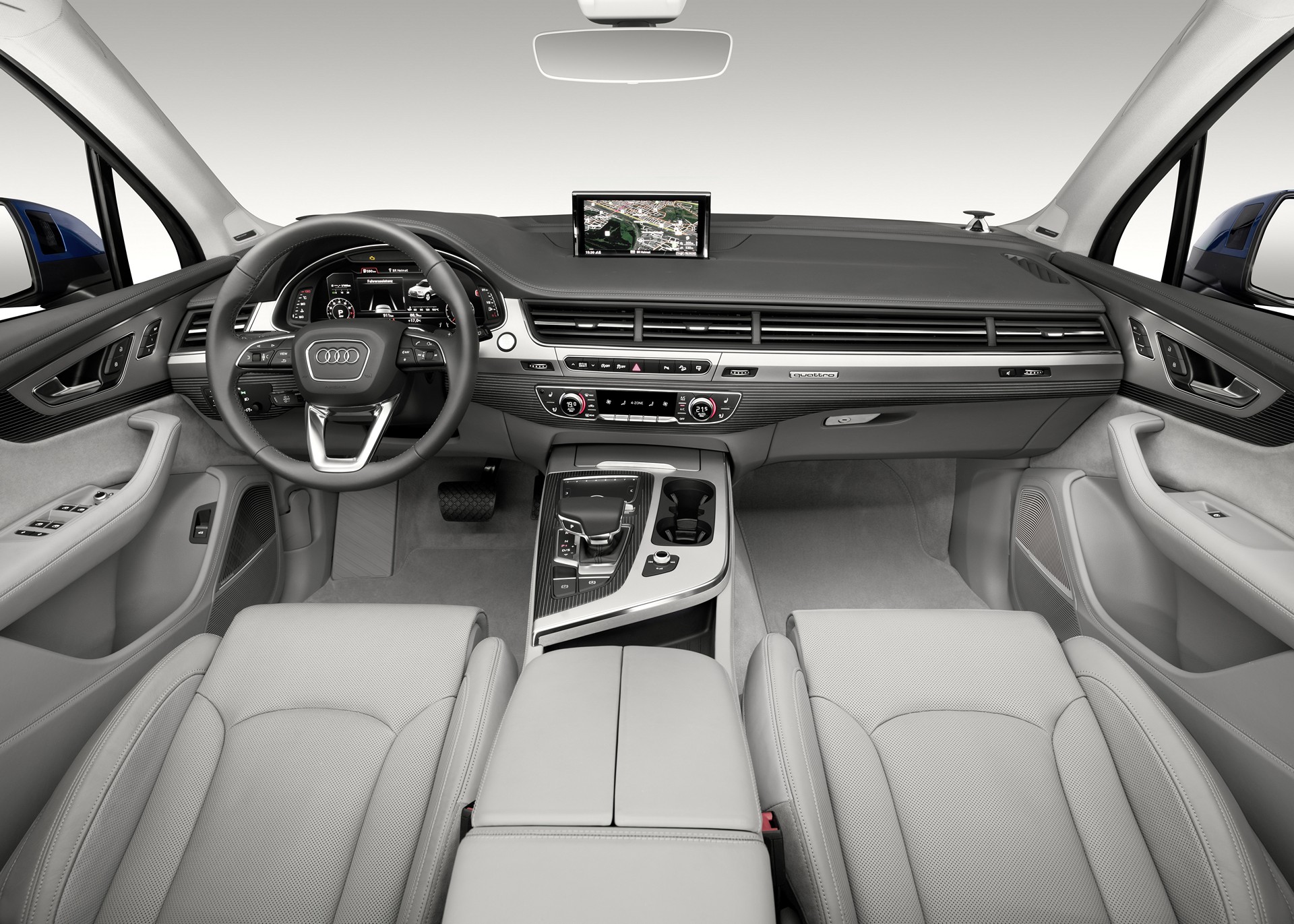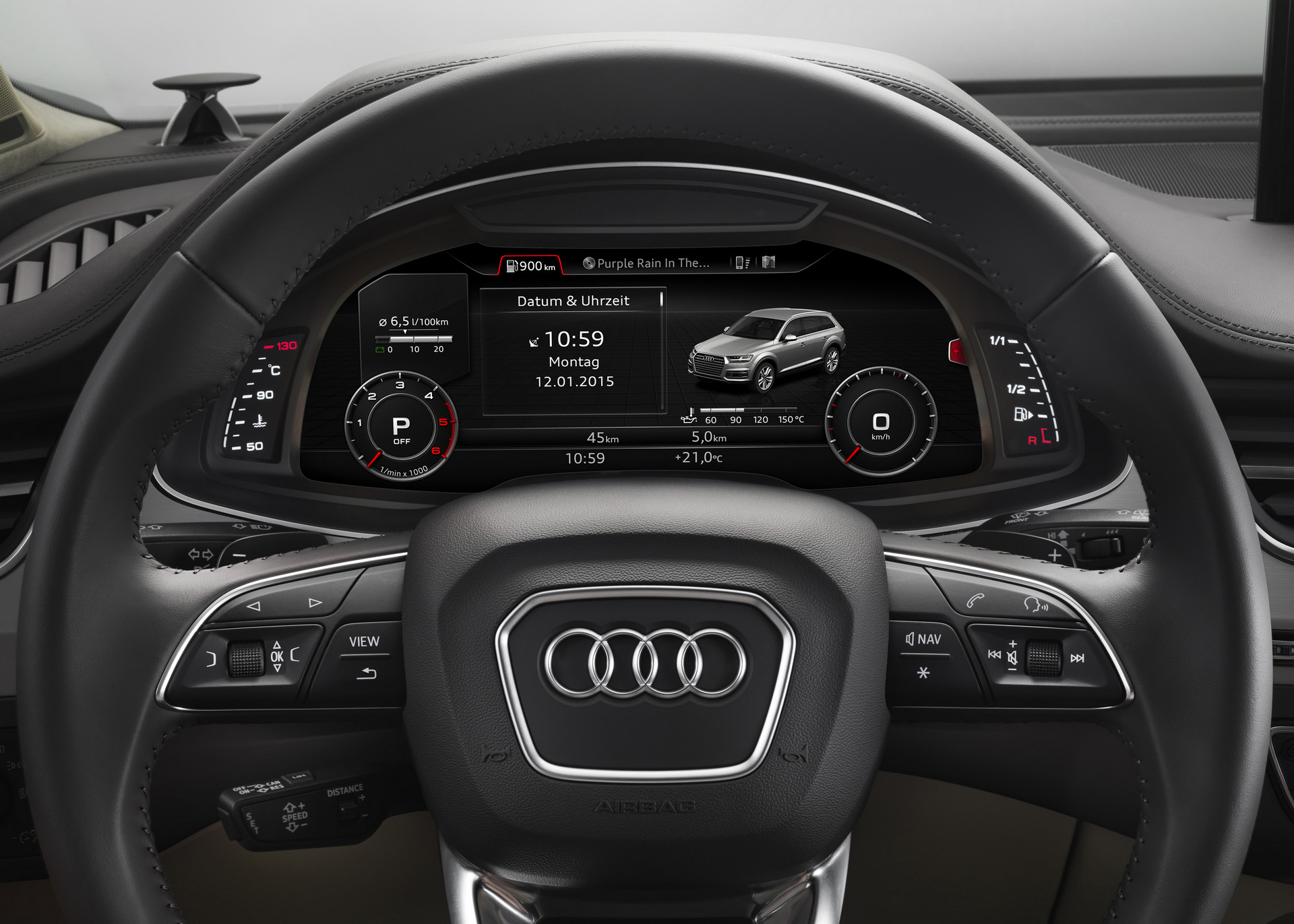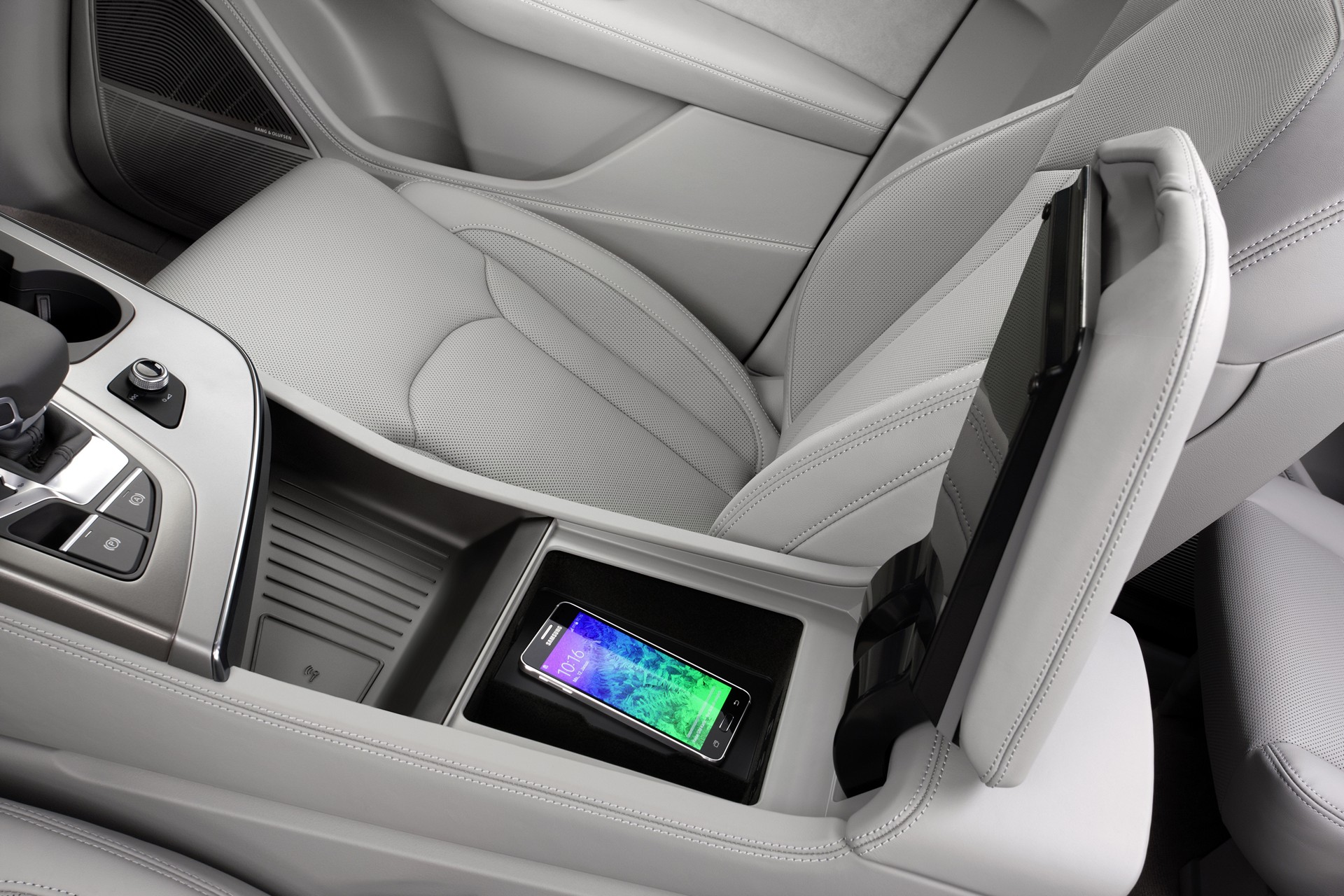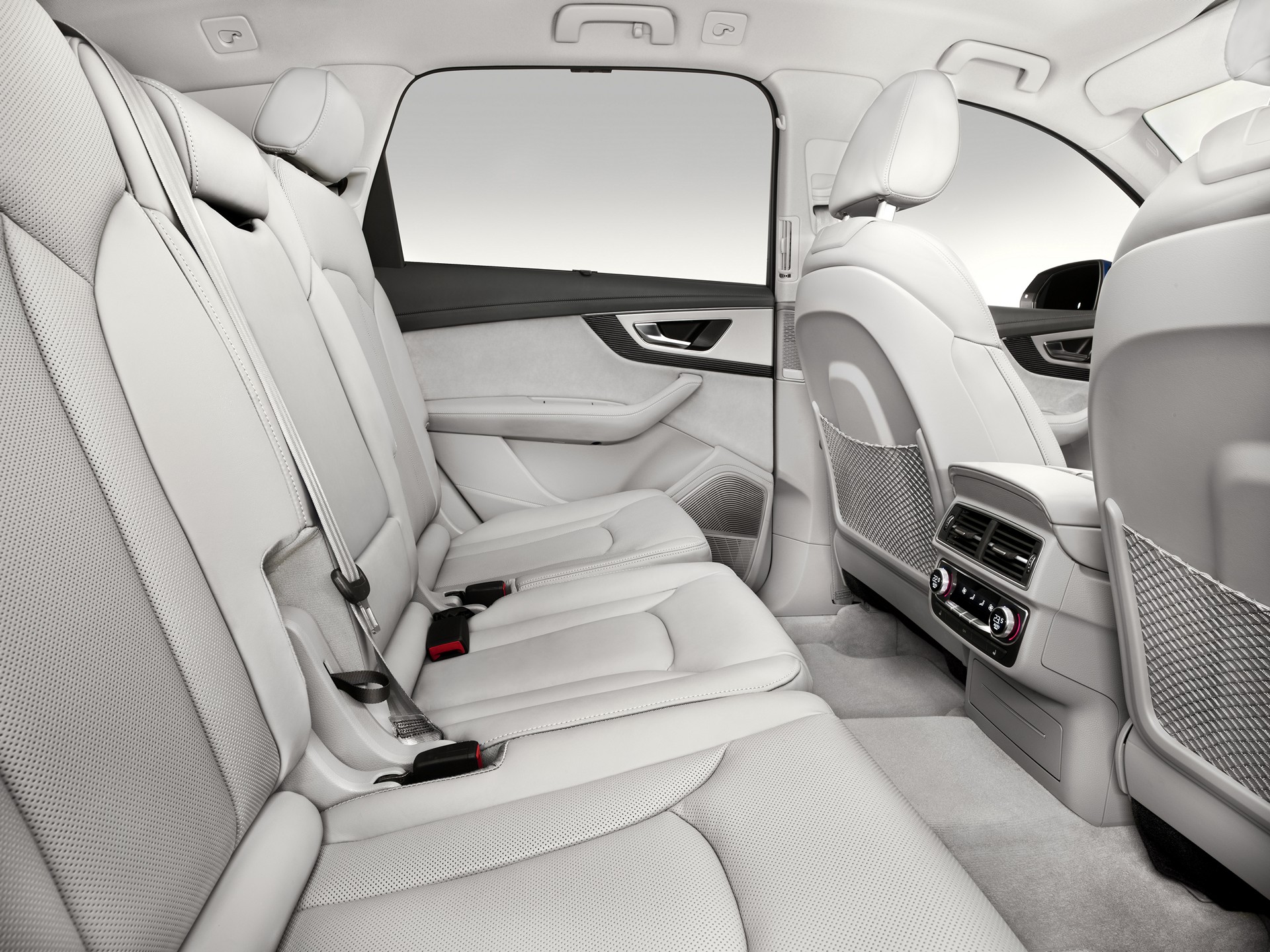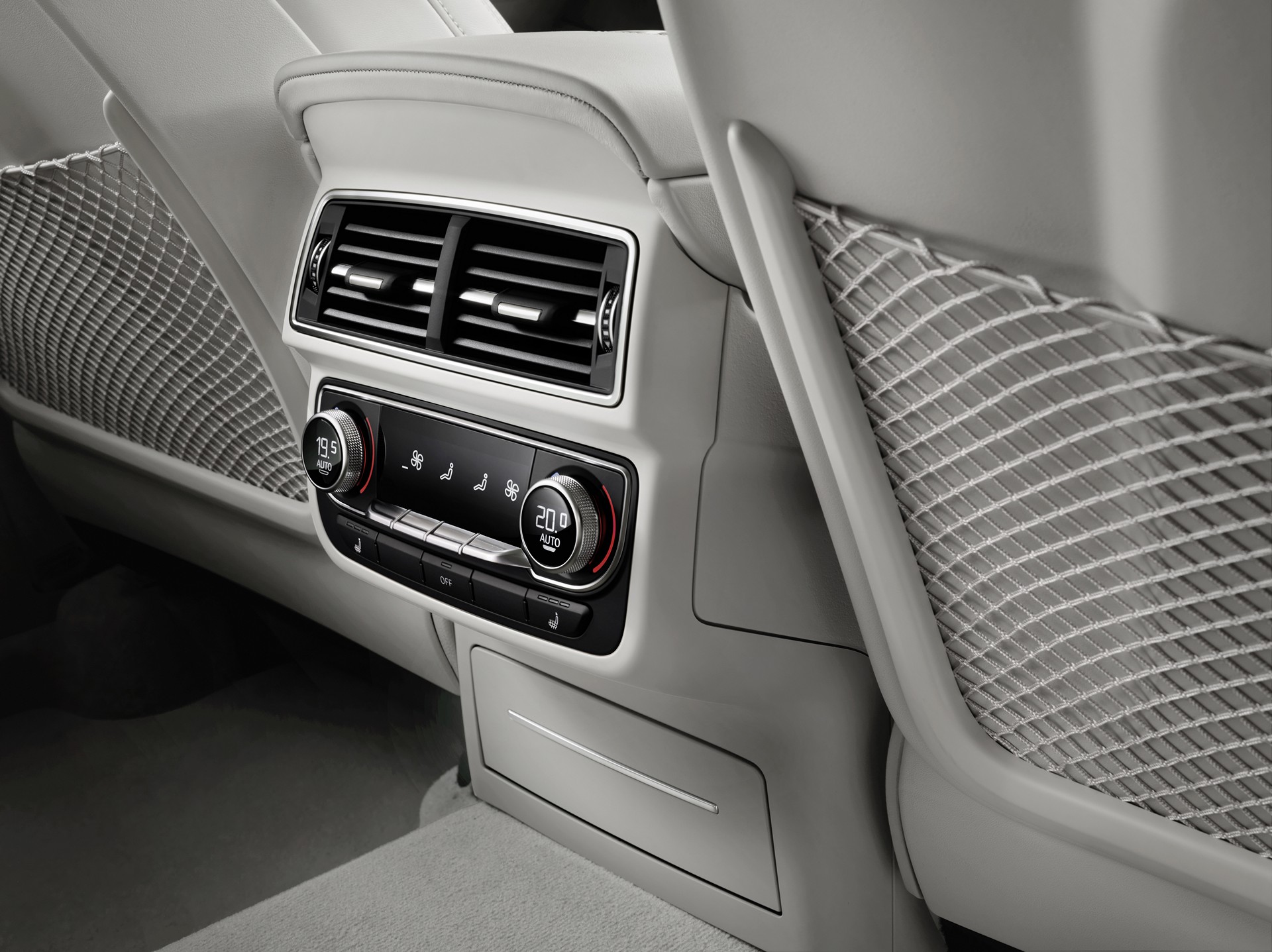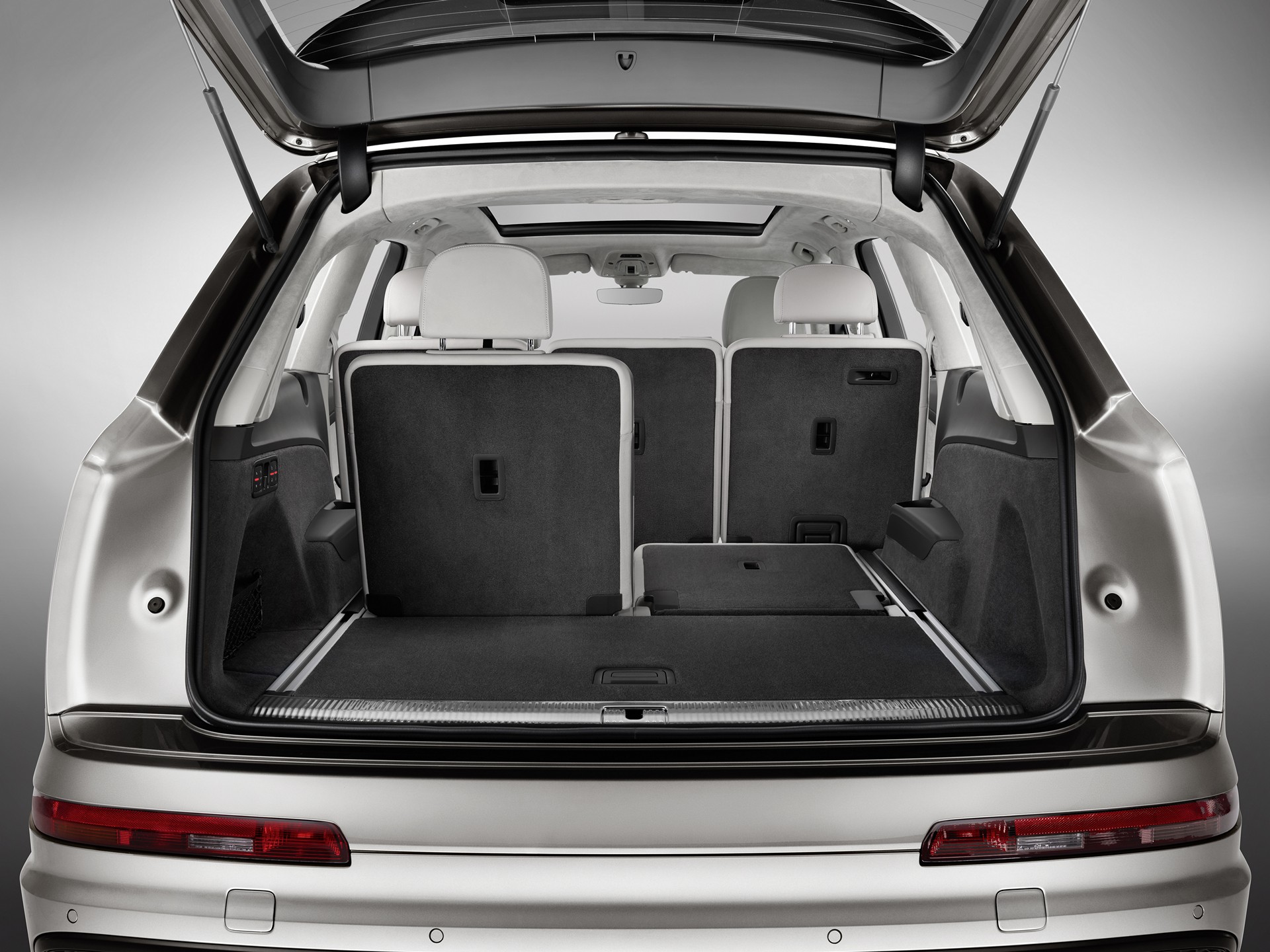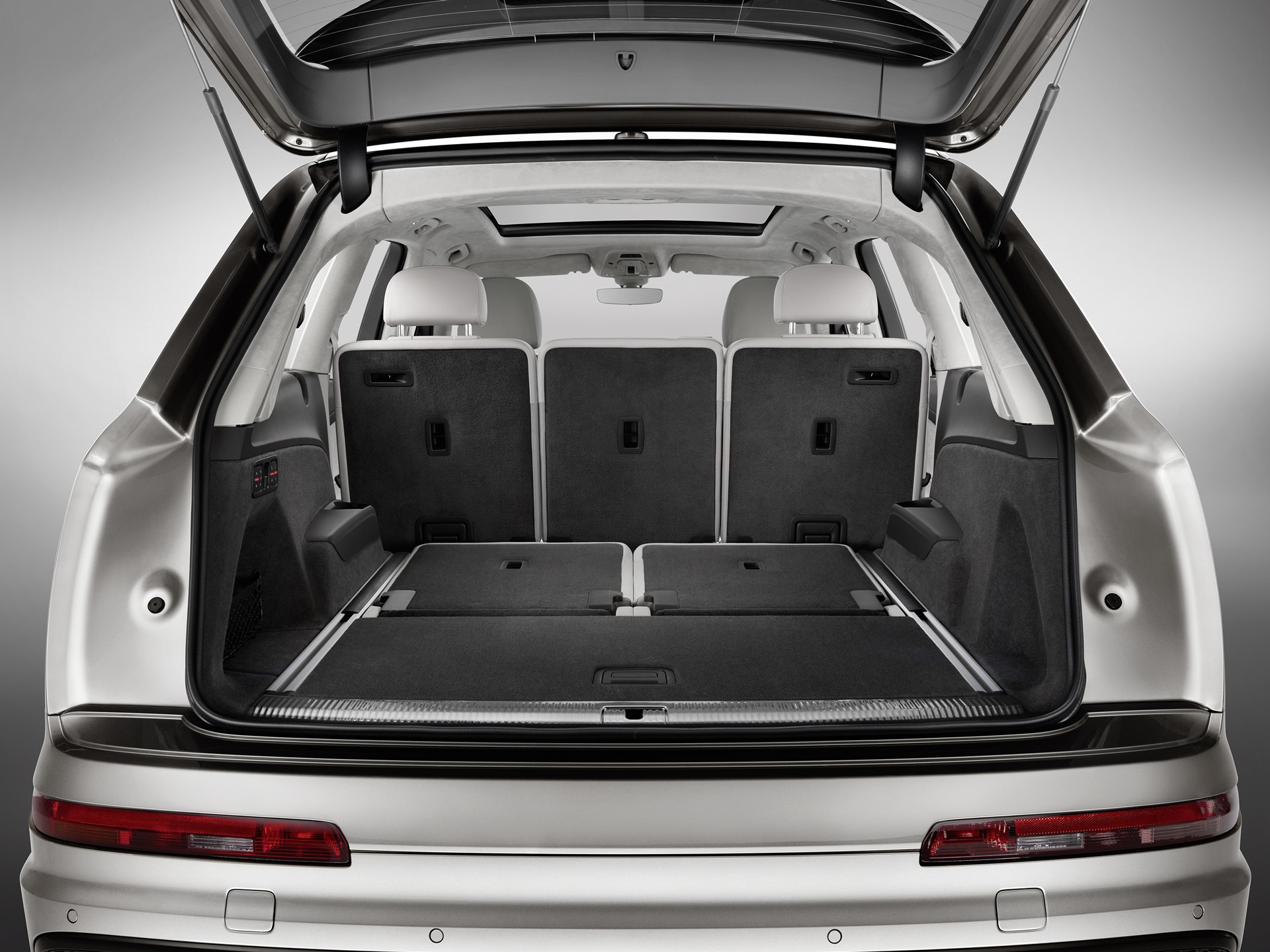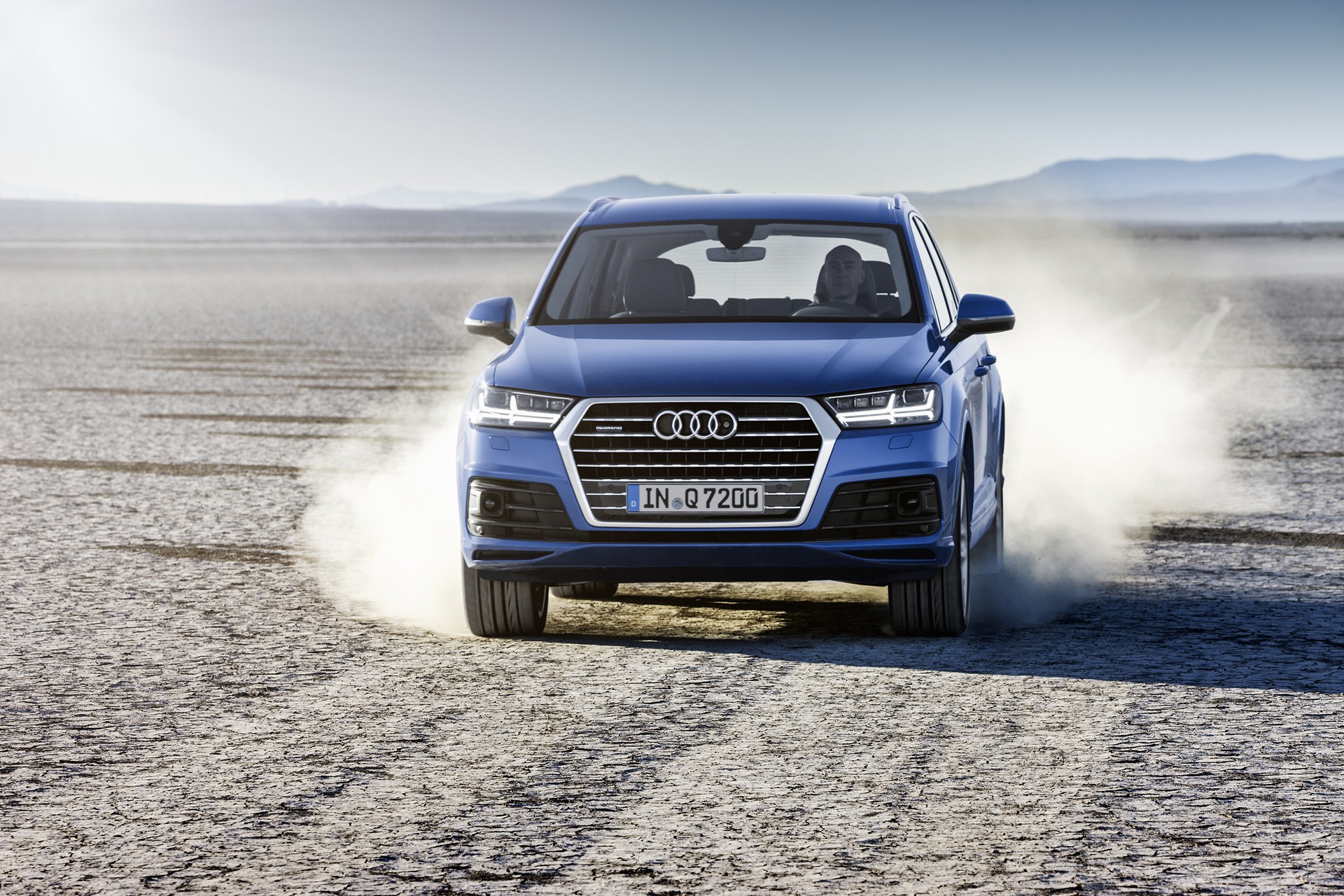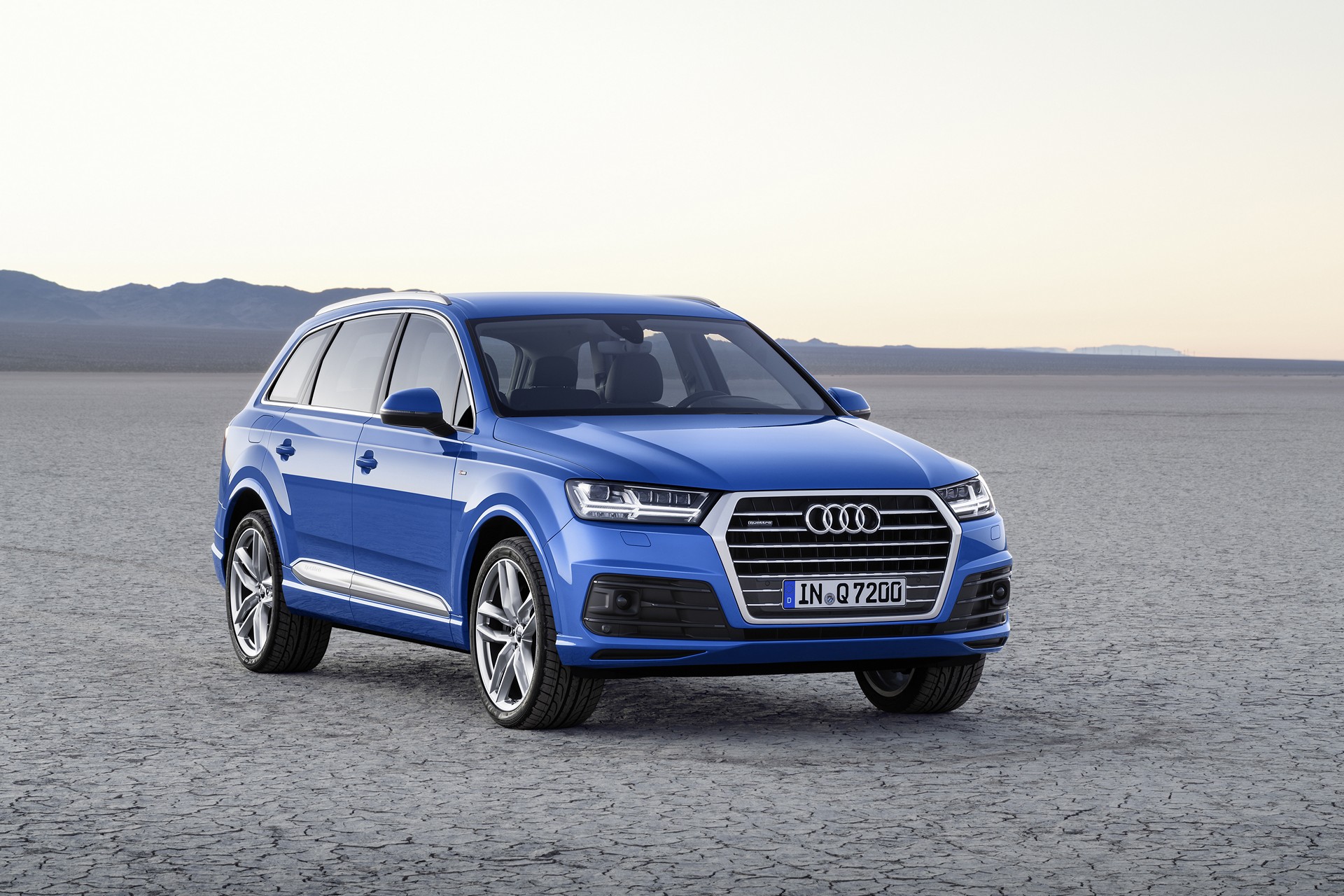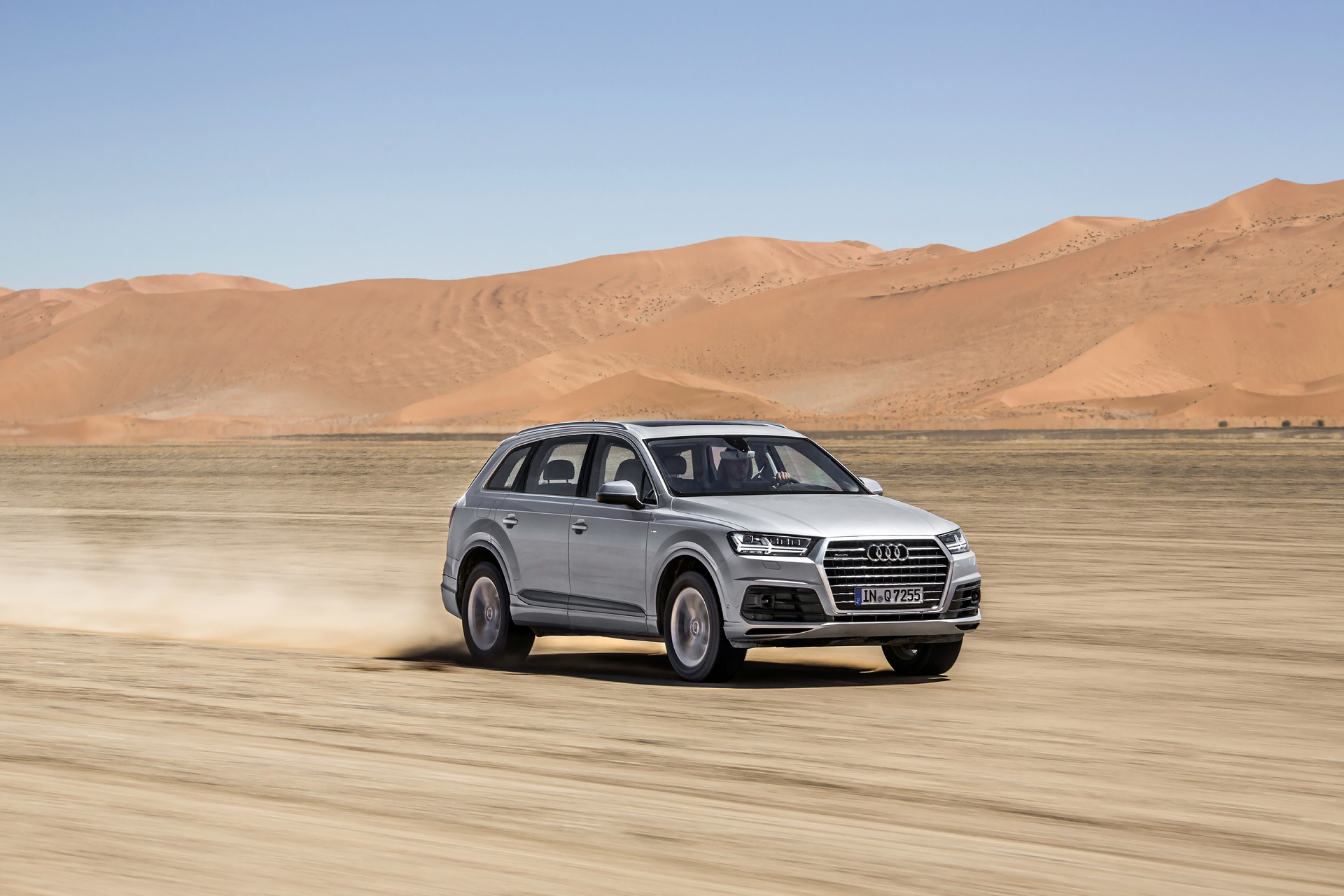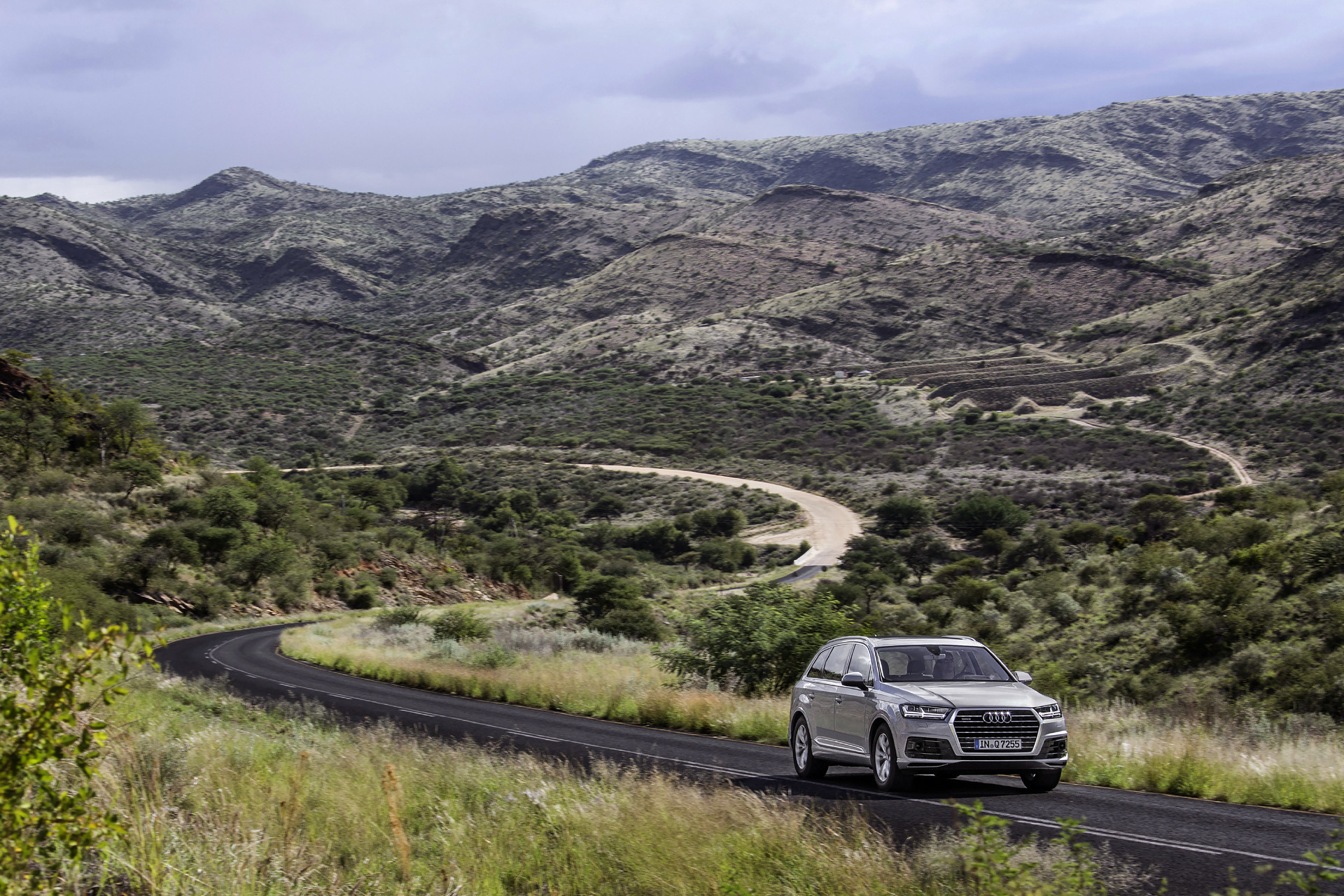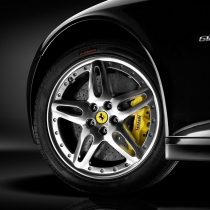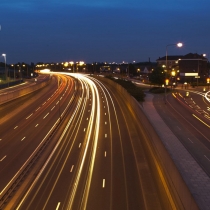Audi is setting new standards with the second generation of the Q7. The large SUV is teeming with innovative solutions in all aspects of its technology – from its lightweight design, drive system and chassis to its infotainment and assistance systems. Its spacious interior is highly configurable and offers luxury-class levels of comfort.
Design and body
The new Audi Q7 has a confident road stance. The sculpted Singleframe grille dominates the front with the daytime running lights forming a distinctive double-arrow pattern in the headlight unit. The trunk lid with standard LED tail lights wraps around the D pillars. Inset moldings with the quattro logo give structure to the lower door areas; the add-on parts follow a new colors and materials concept.
The new Audi Q7 has shed as much as 325 kilograms (716.5 lb) compared with the previous model, depending on the engine. Thanks to Audi’s strict adherence to the principle of lightweight design, the curb weight of the base version is kept under two metric tons (without driver). 71 kilograms (156.5 lb) was saved in just the body, which incorporates many aluminum parts in keeping with its innovative multiple-material construction principle.
https://www.youtube.com/watch?v=6VDQuOl4fK8&feature=youtu.be
Drive system
Two largely new V6 engines are available to power the large Audi SUV. The 3.0 TDI with 200 kW (272 hp) accelerates the five-seater Q7 from 0 to 100 km/h (62.1 mph) in 6.3 seconds (6.5 seconds for the seven-seater), and the 3.0 TFSI with 245 kW (333 hp) accelerates it in 6.1 seconds (6.3 seconds for seven-seater).
When equipped with a diesel engine and five seats, the car’s combined fuel consumption is just 5.7 liters per 100 kilometers (41.3 US mpg) with emissions of 149 g CO2 per km (239.8 g/mi) – 23 percent less than the previous model. Another engine now available for the first time in the Q7 ultra is a 3.0 TDI with 160 kW (218 hp). It has a combined fuel consumption of just 5.5 liters per 100 km (42.8 US mpg) (144 g CO2 per km [231.7 g/mi]). All of the engines are very smooth running.
https://www.youtube.com/watch?v=0e_Om88hFP4&feature=youtu.be
Engine lineup
- 3.0 TFSI quattro with 245 kW (333 hp)
- 3.0 TDI quattro with 200 kW (272 hp)
- 3.0 TDI ultra with 160 kW (218 hp)
Combined fuel consumption in l/100 km: 8.3 – 5.7 (28.3 – 41.3 US mpg);
Combined CO2 emissions in g/km: 193 – 149 (310.6 – 239.8 g/mi)
(Figures vary depending on wheels/tires)
The new Q7 TDI features a new, particularly efficient eight-speed tiptronic as standard. It transfers engine power to the quattro permanent all-wheel drive system.
https://www.youtube.com/watch?v=P6UxExLeyIE&feature=youtu.be
Chassis
The handling of the large SUV is agile and at the same time comfortable. The electromechanical power steering and versatile Audi drive select system are standard. The vehicle can also be equipped with the optional adaptive air suspension and new optional all-wheel steering system that can turn the rear wheels up to five degrees. The wheel suspensions have also been completely redesigned, and compared with the previous model the chassis is more than 100 kilograms (220.5 lb) lighter. The vehicle’s center of gravity has been lowered by 50 millimeters (2.0 in), primarily by installing the engine lower.
Interior and controls
Despite having slightly more compact exterior dimensions than the previous model, the interior of the new Q7 has actually increased in size – it is the most spacious in its segment. The interior feels like a luxurious lounge; it is spacious and light.
A broad continuous air vent strip runs across the front of the cockpit in the passenger area. It ensures an optimal interior climate with the optional 4-zone air conditioning system. Horizontal lines are emphasized by many of the sophisticated two-part trim panels. When it is dark, optional very fine light conductors trace the contours with light. All colors and materials are carefully coordinated. Optional leather packages and a design selection can make the interior even more exclusive.
Three versions of the front seats are available; they offer numerous options up to the customized contour seat with heating, massage and air conditioning functions. Another option is the Audi virtual cockpit – its 12.3‑inch TFT display presents high-resolution graphics. It is supplemented by a head-up display.
Seat back adjustment for the rear seats is standard. The rear bench seat plus option lets users adjust the seats up to 110 mm (4.3 in) longitudinally, and they can accept three child seats. The optional third seat row has a standard power folding feature, and both individual seats are certified as Group III child seats throughout the EU. In the five-seater model the basic configuration of the luggage compartment boasts a volume of 890 liters (31.4 cu ft), and this can be increased up to 2,075 liters (73.3 cu ft). A power tailgate is standard, and gesture control is available as an option in conjunction with the convenience key.
Assistance systems
The new Audi Q7 offers the widest range of assistance systems of any production car in the world. The predictive efficiency assistant helps the driver save fuel, while adaptive cruise control with traffic jam assist takes over the chore of steering in slow-moving traffic. The portfolio of innovations also includes cross-traffic assist, exit warning and trailer assistant. Avoidance assist and turn assist are scheduled to follow shortly after the market launch.
Infotainment
The Audi Q7 offers the very latest evolutionary stage of MMI technology with the optional MMI all-in-touch. The driver and front passenger can input characters on the large glass surface, and they can zoom and scroll using multi-finger gestures. After each input, the finger gets touch feedback. The whole MMI control logic is similar to that of a smartphone, including the intelligent free text search function. The voice control system recognizes inputs made using everyday language, such as: “Where can I refuel?”
https://www.youtube.com/watch?v=M_nsHn5b2bc&feature=youtu.be
The top-of-the-range infotainment system in the Q7, MMI navigation plus, uses the second generation modular infotainment module with its outstanding computing power. Its Wi-Fi hotspot connects the passengers’ mobile devices to the internet, while the LTE module brings the online services of Audi connect into the car. The Audi smartphone interface links cell phones that use iOS or Android technology into the infotainment environment via the MMI monitor.
For hi-fi connoisseurs, two optional sound systems are available: one from Bose and one from Bang & Olufsen with up to 1920 watts of output power and new 3D sound which opens up a new spatial dimension. Up to two Audi tablets can be snapped into place on the backs of the front seats; they serve as a versatile Rear Seat Entertainment system – another pioneering connectivity solution from Audi.
The equipment, data and prices specified in this document refer to the model range offered in Germany. Subject to change without notice; errors and omissions excepted.


